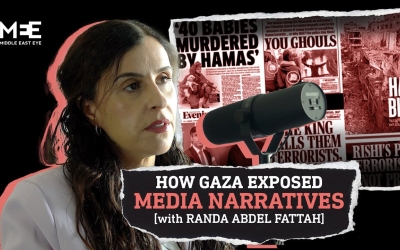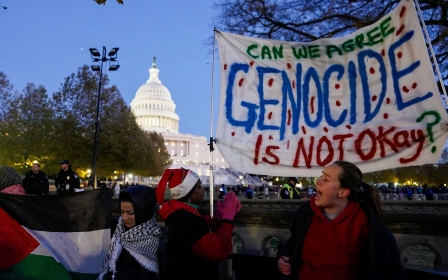War on Gaza: How western media favours Israel on Instagram

Since the onset of Israel's war on Gaza, western media coverage has been at the forefront of discussions.
Complaints have poured in from people and groups on all sides.
Recently, I published what may be the first empirical study on this topic in a major academic journal.
My quantitative content analysis, featured in Journalism & Mass Communication Quarterly, provides concrete, measurable evidence that mainstream western broadcast news outlets demonstrate significantly more sympathy towards Israeli victims and violence perpetrated by Israel than Palestinian victims and perpetrated violence.
The study analysed more than 400 Instagram (IG) posts, including still images, captions and videos from CNN, BBC News, Fox News, MSNBC and Sky News.
New MEE newsletter: Jerusalem Dispatch
Sign up to get the latest insights and analysis on Israel-Palestine, alongside Turkey Unpacked and other MEE newsletters
Several key variables were assessed, including sourcing, victim humanisation and dominant frame.
Based on past scholarly research, I anticipated finding coverage patterns that favoured Israeli narratives and positions. While these expectations were confirmed, the magnitude of the disparities was substantial and, in many ways, surprising.
Sourcing
Sourcing differences serve as an appropriate starting point, especially given their prominence in past research, which has shown that western news outlets routinely privilege Israeli sources.
Consistent with past research, CNN, BBC News, Fox News, MSNBC and Sky News favoured Israeli sources.
Such heavy reliance on Israeli and pro-Israel sources and systematic neglect of Palestinian and pro-Palestine voices is likely to produce imbalances in news reporting
In every category of IG posts - still images, captions and videos - the outlets employed significantly more Israeli and pro-Israeli sources than Palestinian and pro-Palestinian ones.
For example, in the still images category, the outlets used nearly nine times more Israeli sources than Palestinian sources and almost 11 times more pro-Israel sources than pro-Palestinian ones.
In the post captions category, Israeli sources were used approximately four times more frequently than Palestinian sources, and pro-Israel sources were cited nine times more often than pro-Palestine sources.
In video content, sourcing differences were less pronounced yet remained statistically significant.
Notably, these sourcing disparities were observed both when all five outlets were collapsed into a single category and when each outlet was examined individually.
The significance of such pronounced sourcing differences cannot be overstated. Media studies underscore that the emphasis and tone of news coverage are often shaped by the sources used. It is reasonable to assume, then, that such heavy reliance on Israeli and pro-Israel sources and systematic neglect of Palestinian and pro-Palestine voices are likely to produce significant imbalances in news reporting.
Sympathy with victims of violence
One major imbalance identified in the study concerns the level of sympathy shown toward victims. All five news outlets displayed a clear tendency to show more compassion for Israeli victims than Palestinian ones.
On average, CNN, BBC News, Fox News, MSNBC and Sky News published more personal details - names, ages, occupations, hobbies and family relationships - about Israeli victims of violence than Palestinian victims of violence.
The outlets provided 0.47 personal details per IG post about Israeli victims, compared to only 0.14 personal details per post about Palestinian victims. At four of the five outlets, the disparities were even more pronounced.
MSNBC, for example, included an average of 1.14 personal details per post for Israeli victims but only .09 details for Palestinian victims, representing a nearly 13-fold difference.
CNN posts featured an average of 1.33 personal details per post about Israeli victims and an average of .37 details per post about Palestinian victims. At BBC and Fox News, the pro-Israel advantages were 0.52 to 0.07 and 0.20 to 0.02, respectively. Sky News was relatively balanced, providing 0.22 details per post for Israeli victims and 0.16 for Palestinian victims.
Media studies research suggests that this kind of personalisation plays a crucial role in fostering humanisation, as it helps audiences connect more deeply with victims. Consequently, it is reasonable to assume that news audiences may sympathise more with Israeli victims simply because they receive more information about them as individuals.
The study also examined emotional personalised accounts in video posts. These are video reports that provide "sombre details of dead, injured, or missing victims or their families". They often come "in the form of packages highlighting a victim" and are frequently supported "with interviews with family members".
Overall, the news outlets were nearly four times more likely to feature emotional, personalised accounts of Israeli victims than Palestinian victims.
Framing and context
The findings on dominant framing were equally telling.
Approximately 30 percent of posts covering Israeli violence framed Israel's actions as "self-defence" - a stark contrast to posts about Palestinian violence - where only 0.5 percent were framed this way, a 60-fold difference. Conversely, news outlets were about 10 times more likely to frame Palestinian violence as "aggression" compared to Israeli violence.
An overall absence of context critical of Israel, especially in video content posted to IG, contributed to these framing trends. The news outlets largely approached coverage as though the conflict began on 7 October 2023, when Hamas and other armed Palestinian groups attacked Israel.
Follow Middle East Eye's live coverage of the Israel-Palestine war
This approach to reporting excluded crucial context, such as well-documented Israeli aggression during the first nine months of 2023, the ongoing occupation of Palestinian territories and Israel's longstanding blockade of Gaza.
Only 19.5 percent of videos included context critical of Israel. In contrast, the outlets were much more likely to delve into contextual details that were critical of Palestinians, with 50 percent of all IG videos including context critical of Palestinians.
Why are western news outlets so much more likely to apply words like 'slaughter', 'massacre' and 'barbaric' to Palestinian violence than Israeli violence?
These findings align with decades of academic research showing similar patterns, both during other episodes of Israel-Palestine violence as well as during periods of relative calm.
Moreover, during the current war, several other studies have been conducted. Although these were not peer-reviewed, they provide interesting insights.
For example, an analysis of prominent British newspapers by The New Arab found that "emotive nouns" - words like "slaughter" and "massacre" - were routinely used in the context of Palestinian violence but almost never in the context of Israeli violence.
Similar results were found by The Intercept, which examined coverage in major US newspapers. That study revealed that "the term 'slaughter' was used … to describe the killing of Israelis versus Palestinians 60 to 1, and 'massacre' was used to describe the killing of Israelis versus Palestinians 125 to 2".
A separate analysis by Jacobin of the MSNBC programme Morning Joe suggested that the show justified Israeli bombings of Palestinian civilian areas and routinely adopted misleading Israeli claims about the Palestinian death toll.
Making sense of the data
The substantial disparities highlighted in recent studies, as well as many other scholarly studies carried out over many years, beg several questions.
In terms of sourcing, why are mainstream western news outlets so reliant on Israeli sources?
Western outlets clearly have access to Palestinian and pro-Palestinian sources, as demonstrated by occasional consultations with them. Why, then, is a greater effort not made to amplify these voices?
Regarding the descriptive labelling of violent acts, why are western news outlets so much more likely to apply words like "slaughter", "massacre" and "barbaric" to Palestinian violence than Israeli violence?
Jodi Rudoren, the current editor-in-chief of The Forward and former New York Times Jerusalem bureau chief, offered up one defence.
In an October 2024 episode of Al Jazeera's The Listening Post, she stated: "There was a massacre [against Israelis] on 7 October [2023]… It was barbaric. I think those were appropriate words to use."
Rudoren argued that such terms are not "appropriate" for describing Israeli violence, which she characterised as a "response" to the Hamas attack.
Rudoren's argument overlooks a critical point, however. Even if Israel's assault on Gaza is framed as a response to Palestinian violence, this does not preclude the possibility of the response being "barbaric". It is entirely possible for a response to be "barbaric" or to involve "massacres" and "slaughters".
Moreover, and significantly, the UN, genocide and Holocaust scholars, and experts in international humanitarian law have described Israel's actions in Gaza as constituting a "textbook case of genocide".
Genocide is often referred to as "the crime of crimes", making it one of the most extreme forms of violence possible. Evidence presented during South Africa's genocide case at the International Court of Justice, as well as hundreds of videos posted to TikTok by Israeli soldiers, highlight the war's devastating impact on Gaza's civilians, particularly women and children, and document apparent atrocity crimes.
Additionally, Israeli media has used military sources to report on military policies that constitute blatant war crimes. These policies include the 100:1 ratio, which allows Israel to kill more than 100 civilians in order to kill a single Palestinian commander; the "Dahiya Doctrine", which calls for the targeting of civilians as a form of collective punishment; and various "kill zone" policies.
Given this context and the extraordinarily high civilian death toll in Gaza, it may not be unreasonable for western broadcast news outlets to characterise acts of Israeli violence as "massacres" and "slaughters".
The reporting discrepancies described here are more troubling when one considers the disparities in casualties. At every phase of the current war, Palestinian casualties have far exceeded Israeli casualties.
Why, then, do mainstream western broadcast news outlets cover Israeli victims so prominently and seemingly neglect Palestinian victims? In light of the data, this, too, is a fair question.
Internal tensions
There is no grand conspiracy at play. Journalists are not sitting in meeting rooms cooking up schemes to paint Palestinians as monsters and Israelis as innocent. Most individual journalists want to get stories right.
But news production processes are fundamentally constrained by ideologies, editorial policies, news gathering routines, governments, corporations, special interest groups and the journalistic balance doctrine, among other things. It is also possible, of course, for individual journalists to produce shoddy work.
These explanations notwithstanding, the findings described here are troubling. Decades of research into western reporting of Israel-Palestine, as well as findings from the current war period, suggest a lot of soul-searching is in order.
In what may be a good sign, American and European journalists appear to be increasingly aware that their news organisations are falling short.
For example, significant disagreements emerged at the New York Times over the its publication of an investigative report about alleged 7 October sexual violence by Hamas.
Internal pushback over the report, many aspects of which were later debunked by multiple outlets, forced the New York Times to scrap a scheduled podcast episode about the report.
Underscoring the internal tension at the paper was the decision to launch an internal investigation - described by some staffers as a "witch hunt" - into how editorial details about the podcast's cancellation were leaked.
Earlier this month, more than 100 anonymous BBC staffers signed a letter to the BBC's director-general, Tim Davie, complaining that the broadcaster's reporting about Gaza was overtly pro-Israel and had violated "basic journalistic tenets".
Also, in October, Al Jazeera interviewed 10 CNN and BBC journalists who have covered the current war and who complain of "systematic double standards" in their news organisations' reporting.
International human rights lawyer Craig Mokhiber has argued that western news organisations could be held legally accountable for facilitating genocide
Increasingly, news audiences are noticing reporting problems and voicing their frustration on social media. Even cursory glances at the comments and "likes" under mainstream western media's posts reveal widespread disenchantment.
The hope, then, is that the research, employee complaints and audience comments could lead to serious dialogue, introspection and change at mainstream western outlets.
Such reflection is not just an ethical imperative but could also have legal significance. International human rights lawyer Craig Mokhiber, a former director in the Office of the High Commissioner for Human Rights, argued recently that western news organisations could be held legally accountable for facilitating genocide.
For a variety of reasons, legal accountability of this sort is highly unlikely. However, news organisations would still be wise to engage in self-reflection.
This would aid in their efforts to uphold truth and fairness. Importantly, it could also bolster credibility and mitigate criticism from audiences, scholars, employees and legal experts like Mokhiber.
The views expressed in this article belong to the author and do not necessarily reflect the editorial policy of Middle East Eye.
Middle East Eye delivers independent and unrivalled coverage and analysis of the Middle East, North Africa and beyond. To learn more about republishing this content and the associated fees, please fill out this form. More about MEE can be found here.








